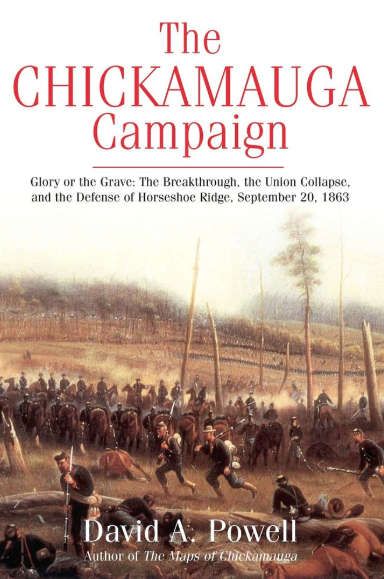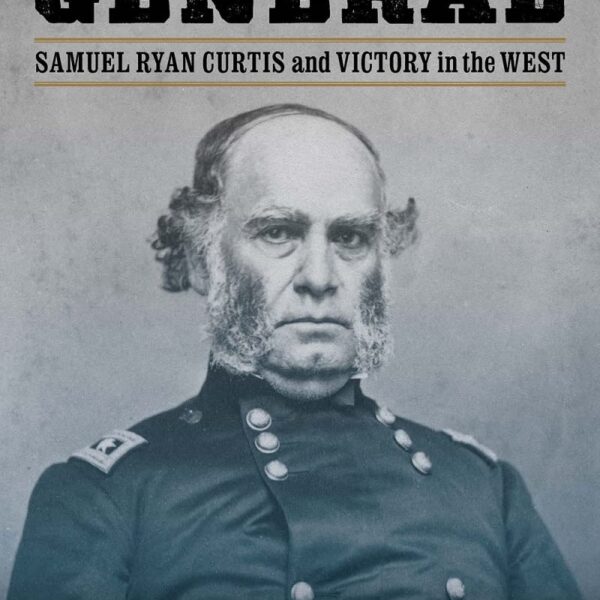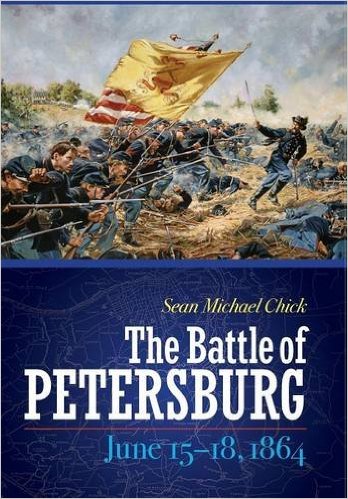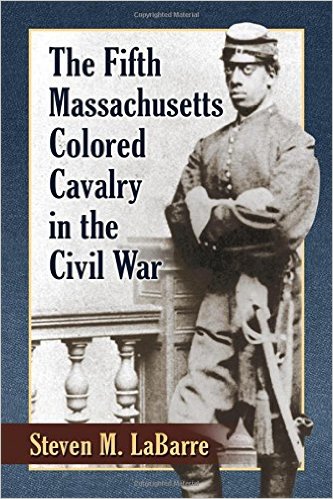The Chickamauga Campaign—Glory or the Grave: The Breakthrough, the Union Collapse, and the Defense of Horseshoe Ridge, September 20, 1863 by David A. Powell. Savas Beatie, 2017. Paper, ISBN: 978-1611213836. $22.95.
 Civil War battle histories fall into one of at least three categories: introductory volumes, “war and society” studies incorporating social and cultural elements, and exhaustive tactical and operational treatments devoured by enthusiasts. David A. Powell contributes impressively to the lattermost category with The Chickamauga Campaign – Glory or the Grave: The Breakthrough, the Union Collapse, and the Defense of Horseshoe Ridge, September 20, 1863. This is the second part of his trilogy on the eponymous campaign, about which he has also written two additional books. Rather than an overarching argument, he provides an “exploration of the often-differing viewpoints of the numerous participants, concluding with what I think happened” (x).
Civil War battle histories fall into one of at least three categories: introductory volumes, “war and society” studies incorporating social and cultural elements, and exhaustive tactical and operational treatments devoured by enthusiasts. David A. Powell contributes impressively to the lattermost category with The Chickamauga Campaign – Glory or the Grave: The Breakthrough, the Union Collapse, and the Defense of Horseshoe Ridge, September 20, 1863. This is the second part of his trilogy on the eponymous campaign, about which he has also written two additional books. Rather than an overarching argument, he provides an “exploration of the often-differing viewpoints of the numerous participants, concluding with what I think happened” (x).
The night of September 19, exhausted Union General William S. Rosecrans consolidated forces; for his part, Confederate General Braxton Bragg reshuffled his reinforced army into two wings under Major Generals James Longstreet and Leonidas Polk. Noting Bragg’s fractious relationship with the latter, Powell judges his “decision to both expand Polk’s authority and assign him the primary offensive role…misguided” (28). Major General Daniel Harvey Hill, part of Polk’s right wing, delayed the dawn attack on September 20 due to poor unit dispositions and reconnaissance. Left wing commander Longstreet arrayed fourteen brigades in deep columns to maintain command and support. Polk’s men were unable to pushthe Union left into Longstreet’s path, partially because apathetic Polk and Hill favored piecemeal deployments.
Meanwhile, Rosecrans’s perplexing orders in support of Thomas caused major generals Alexander M. McCook and Thomas L. Crittenden to repeatedly shift units. Powell describes his oversight of divisional movements as “minor decisions an army commander was [not] supposed to concentrate upon” (184). Rosecrans, unaware that Brigadier General John M. Brannan’s men covered Major General Joseph J. Reynolds’s flank, nonsensically directed Brigadier General Thomas J. Wood to close up on Reynolds. McCook pushed Wood to comply given Thomas’s plight, yet in allocating blame, the author foregrounds Rosecrans’s moving of the whole right wing within a mere fifteen minutes.The Northern line fell back before Longstreet, but then rallied and inflicted heavy casualties.
A Union command crisis emerged as the micromanaging Rosecrans journeyed to Chattanooga to oversee tasks he doubted his staff could perform; Crittenden followed suit and McCook exerted feeble authority over the right. The tide turned when Federals employed a fire-and-advance tactic, and Brannan formed a defense atop Horseshoe Ridge. Since Major General James S. Negley did not contact Thomas, he mistakenly deployed on the Ridge, consequently exiting the battle due to the endangered left flank and lack of forthcoming aid. This denied the army a sizable force of infantry and artillery. Powell highlights Longstreet’s contribution: diverging from Bragg’s strategy by pivoting northward, he “made an important reconnaissance and several significant decisions that would affect…the battle” (451). Confederate offensives against Thomas failed given the troops’ bloodied condition, straggling, and a stout Union defense. Hill delayed his advance at that time by requesting troops and decrying a now-filled gap in his lines, demonstrating a mediocre understanding of his own position.
The Union leadership was crumbling; although Thomas was unflappable, Major Generals Philip Sheridan and Reynolds championed withdrawal and left the field, respectively.Powell insists that Rosecrans did not spoil Union victory by demanding that Thomas retreat to Rossville. The “Rock of Chickamauga” lacked ammunition for his scattered troops, and the reinforced Confederates could launch a combined attack on Thomas’s center and flanks. Ultimately, the opposing forces had suffered substantial losses. The author concludes that, “the Army of the Cumberland had been decisively defeated – but not destroyed” (707).
Glory or the Grave offers much for those looking to master the narrative of the second costliest Civil War clash. Powell investigates differing primary accounts as well as the historiography, and readers can do so as well by examining the convenient footnotes. Straightforward prose and David Friedrichs’s thirty-seven remarkably clear maps aid in comprehension; nevertheless, extensive detail renders this tome less approachable for novices. For this reviewer, some questions remain: how did the Union and Confederate leadership’s record at Chickamauga differ from those of, say, Antietam and Gettysburg? In comparison with other armies, did the institutional culture of these contending forces lead them to perform differently at the small-unit level? Powell does not contextualize these events within the Civil War or military history more broadly. And yet, several themes emerge: the dangers of fraught officer relationships, the complexities of moving a nineteenth-century army, and a leader’s ability to change the course of events despite initial reverses.
Alexandre Caillot is a Ph.D. candidate at Temple University, where he is working on a dissertation about the Army of the Potomac’s final year.




